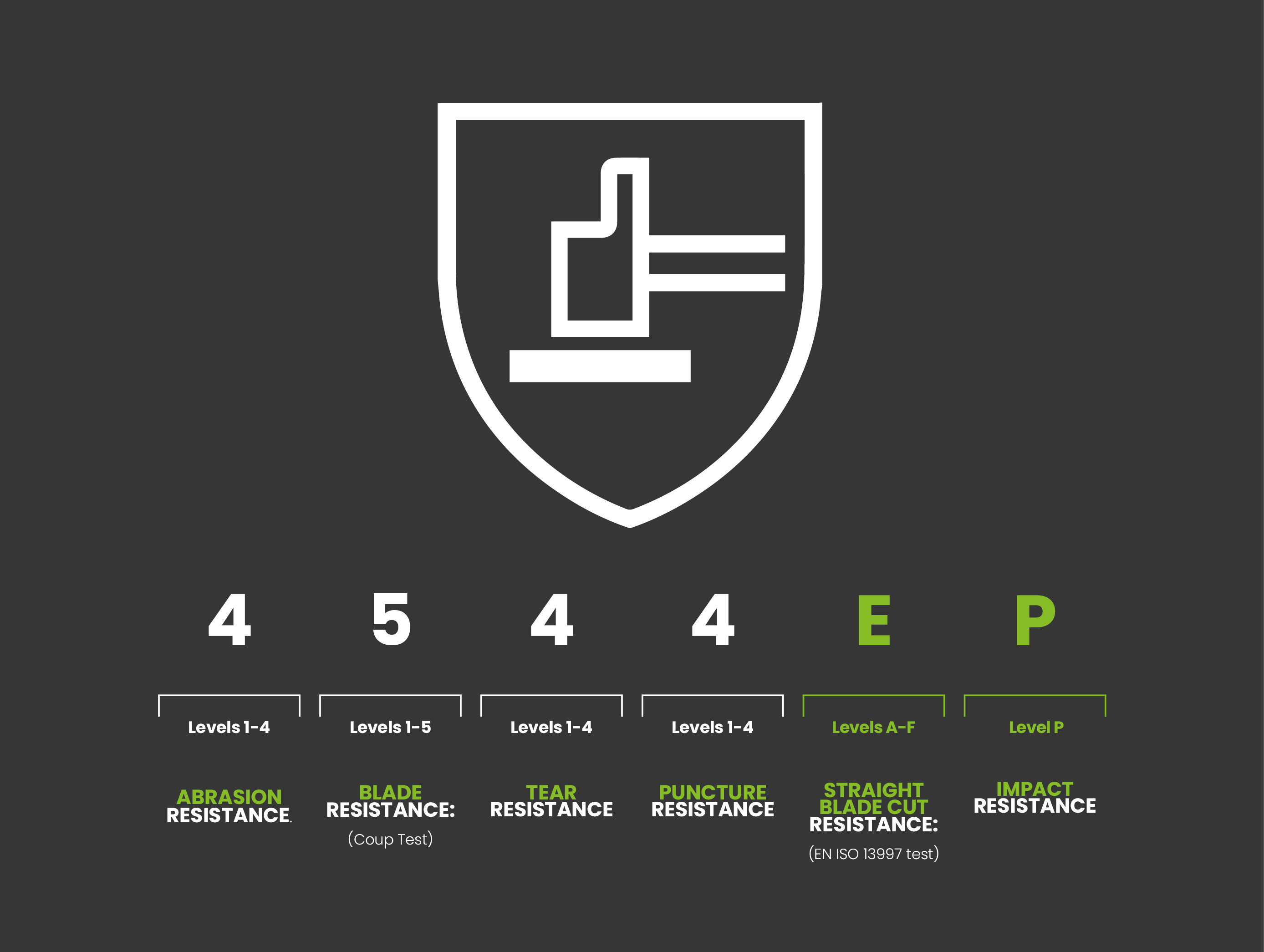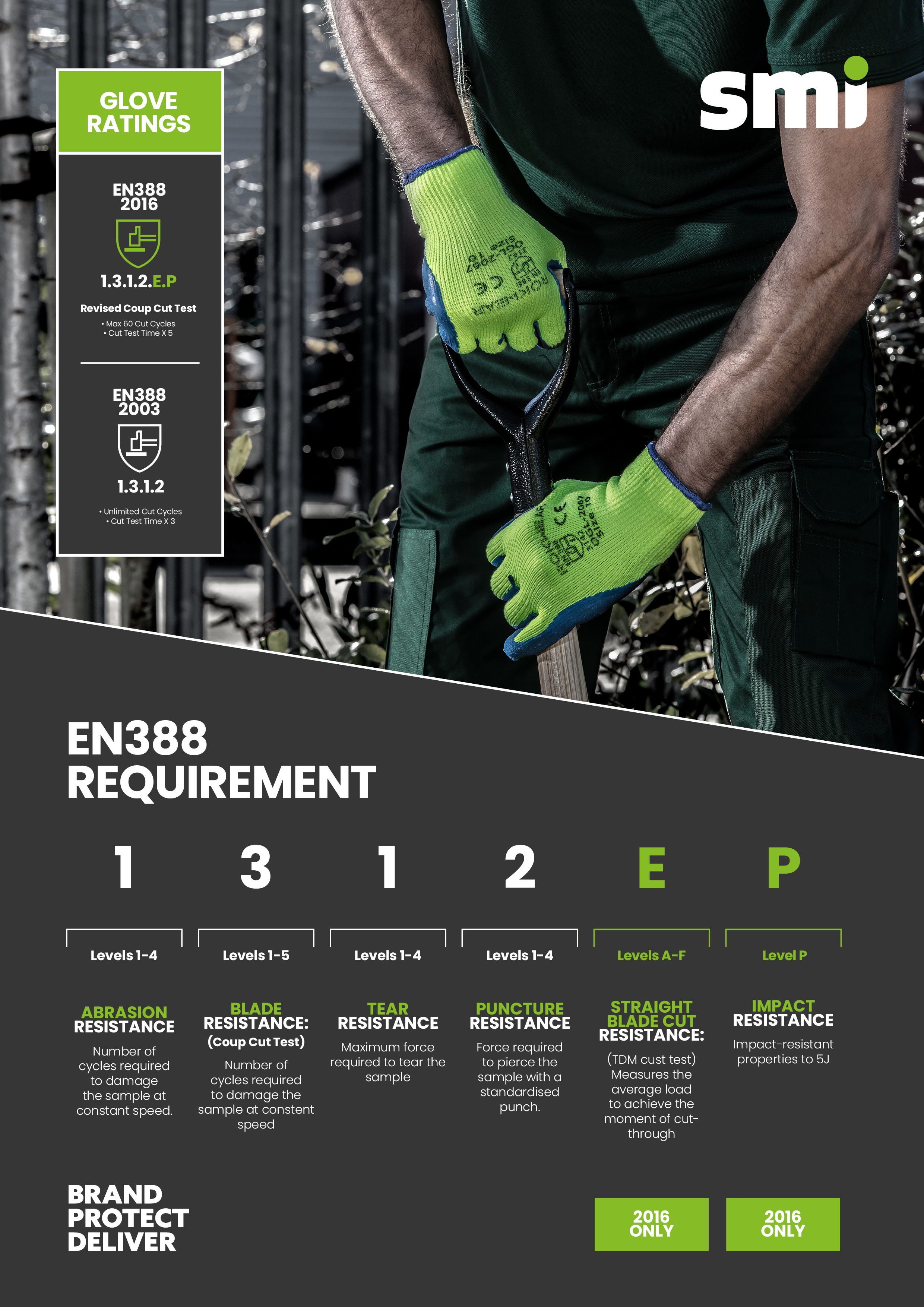Grasping Hand Protection Ratings
7 minute read

In most workplace environments, we use our hands and rely upon them more than any other part of the body. These valuable commodities are essential in all aspects of our lives, enabling us to undertake activities with dexterity and efficiency. It stands to reason, therefore, that the right hand protection is one of the most fundamental elements of our overall Personal Protective Equipment and workwear.
Despite the advancements made in protection for the hands, many workers face daily hazards in the workplace that risk hand safety. The Health & Safety Executive reports that plant, process and machine operatives experience significantly elevated rates of hand injury, in comparison with workers in other sectors.

Injury arising from contact with machinery, and activities such as handling, lifting or carrying objects present significant risks which require outstanding hand protection to safeguard against injury. To facilitate the safe deployment of PPE in your organisation, we’ve compiled a comprehensive overview of the various hand protection ratings and their application in specific working environments.
According to the Health & Safety Executive (HSE), in 2019 there were:
- 581,000 working people sustained an injury at work according to the Labour Force Survey
- 69,208 injuries to employees reported under RIDDOR
- 28.2 million working days lost due to work-related illness and workplace injury
- £15 billion estimated costs of injuries and ill health from current working conditions.
With hands being the most used part of the body for the majority of working environments, it stands to reason that these can be the most commonly-affected area if risks are not mitigated, or working conditions not maintained at optimum. Equipping your team with the right hand protection is not an inclusive solution for hand safety in the workplace – it’s important that business owners also conduct environmental and site-based risk assessments, to identify and mitigate potential injury and hazards. It’s also important that your team are trained to operate machinery and tools safely, and follow established and approved methods of work for each task which may potentially give rise to risks of hand injury.
When it comes to deploying hand protection for your workforce, the products you select need to be durable, comfortable and fit for purpose. It’s your responsibility to ensure that your team have well-fitting and comfortable hand protection, as ill-fitting products are less likely to be used in the workplace. Similarly, once you have selected the appropriate degree of protection for your team, it’s important that you maintain a schedule of checks to ensure that the products maintain their integrity and level of protection, over time.
Understanding EN 388:2003
EN 388:2003 is the standard for hand protection applicable until 2016. It was considered to be best practice for a number of years, until such time that technology evolved in the safety sector, and the standard needed to be updated to reflect the introduction of enhanced materials and manufacturing methods. The standard was considered to be satisfactory for lower cut resistance gloves, but a number of flaws were identified for higher cut resistance (levels 4-5), which grouped glove types together with significant performance variations and degrees of protection. Materials and manufacturing methods outpace the standards, leading to the EN 388:2016 standard being implemented.
Under the old Standard, a glove with a cut index of 5 would be classed as having the same cut resistance as a glove with a cut index of 9.9 – almost twice the level of cut resistance. EN 388:2016 provided more accurate performance data, to enable a more informed decision about the level of protection offered by a specific glove. Manufacturers were permitted to introduce gloves on to the market under the EN 388:2003 certification, until April 21st, 2019.

Introducing EN 388:2016
Many of the fundamental aspects of EN 388:2003 remain intact with the revised standards. The test determines a protective glove’s performance against the primary mechanical hazards:
- Abrasion
- Blade Cut
- Tear
- Puncture
Every glove achieves a performance rating expressed by a pictogram, followed by four numbers representing performance against each specific hazard. The higher the numerical rating (0-4 for abrasion, tear and puncture/0-5 for blade cuts), the higher the protection offered. Although EN 388:2003 results were seen as a satisfactory indicator for gloves with lower cut resistance, a number of flaws were identified for those with higher cut resistance (cut levels 4-5).
The liners used with the latter that are blended with glass fibre can blunt the microscopic edge of the blade used in the Coup Test, while steel-based engineered yarns can stop the testing machine due to metal-to-metal contact without necessarily cutting through the material.
As a result, potentially large performance variances and inconsistent cut indices existed. The 2003 standard used the Coup Test method to assess the cut resistance performance. In the 2016 standard, the same test is still used but has been improved. Now, there is a maximum test cycle of sixty, regardless of whether the blade permeates the fabric or not, to address some of the inaccuracies in tests which the former method identified as having. With the new approach, if a sample blunts the knife blade by a factor of three or higher after the second fabric cut, EN ISO:13977 cut resistance standard becomes the reference test method. There are now six letter-based classification ratings, as opposed to the previous four.
Categorisations of cut-resistant hand protection
The revised levels for categorising cut resistance provide greater performance results. Going from low – high to determine cut resistance, the revised levels include: A (2N), B (5N), C (10N) D (15N) – higher than the previous ISO cut level 4 (13N), level E (22N) – the same as the previous cut level 5, and level F (30N) which is a new, higher level. Results are categorised as follows:

The following infographic clarifies the current Hand Protection ratings:

Testing protocols relating to Hand Protection
There are a number of protocols in place governing the compliant testing of abrasion and impact resistance, strengthened as part of the 2016 standard revision. Under the current testing process, the type of paper used for abrasion testing has been changed. Testing compromises fitting the glove to a Martindale abrasion machine, and moving the head over the material in an elliptical motion, over a table covered by 180 grit abrasive material.
The cycles it takes to create a hole in the glove correlate with the 1-4 level of abrasion performance. For Impact Resistance testing, the process is governed by EN 13594:2015 6.9 – ‘Protective Gloves for Motorcycle Riders’. The protective area is secured to a domed anvil and impacted with a 2.5kg flat face striker and energy of 5J. Gloves must meet the requirement of level 1 of EN 13594:2015. The mean transmitted force shall be ≤7.0kN with no single results greater than ≤9.0kN. If the glove meets this requirement, a ‘P’ is added as the last digit to the EN388: 2016 glove marking. The following graphic illustrates the performance results:

If you’re considering having a Hand Protection review for you and your team, let us help. At SMI, we have trained and experienced Safety Consultants able to provide you with a tailored recommendation of the ideal products to suit your industry sector and requirements. Get in touch with us today, and ensure your workforce benefit from high-quality, robust and certified safety products. Have you identified any additional information which we may include in this guide? If so, we’d love to hear from you, and share your knowledge across our customer base!